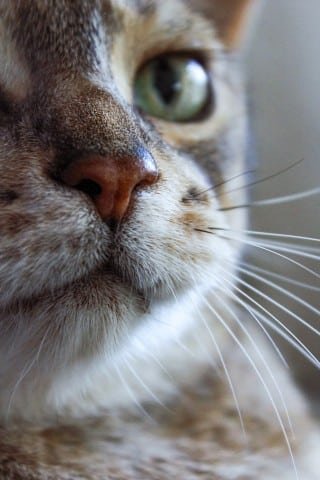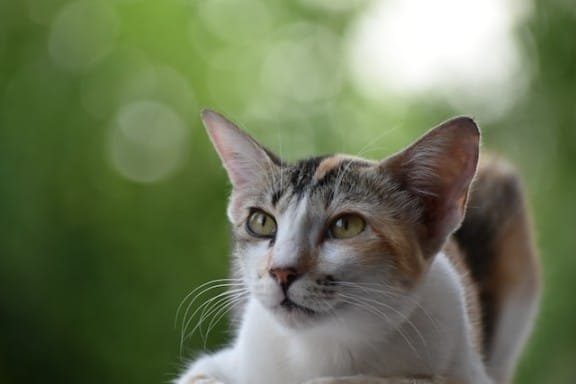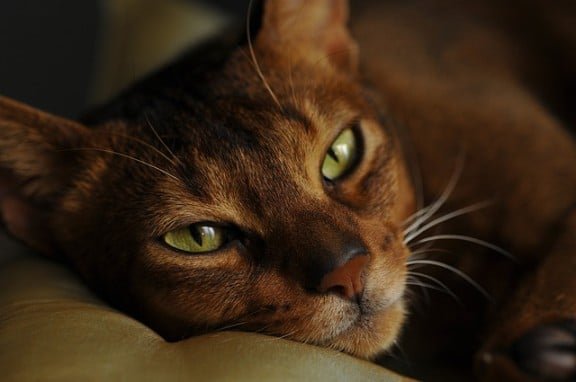My friend got a new cat recently, and yesterday I went to see it. I was amazed by the vibrant gold-orange color of the fur and the beautiful body proportions of this cat. Later, my friend told me it was an Abyssinian cat, and although I had heard about this breed before, my knowledge about it was quite limited.
Also known as Abys, Abyssinian cats are one of the oldest cat breeds. Their origin can be traced back to Ancient Egypt, 4000 years ago. Even today, this cat breed is quite popular, so stay with me while I discover more interesting facts about this cool cat!
Abyssinian Cat Characteristics
Appearance
| Fur color | Reddish-brown with black ticking (also known as “usual”), ruddy, tawny, sorrel, blue, and fawn. |
| Fur pattern | Ticked, which means each hair is banded with different colors. |
| Fur length | Short |
| Eye color & shape | Amond-shaped, gold, copper, hazel, or green, depending on the fur color |
| Length | Males 12”-16” Females 10”-12” |
| Weight | Males 7-10 lbs Females 6-8 lbs |
| Expected lifespan | 9-15 years |
Personality
| Temperament | Considered the smartest cat breed, playful, willful, extroverted, loyal, loving, and affectionate. |
| Kids and other pets | Yes, it is one of the best cat breeds for children, and it can have a nice relationship with other pets. |
| Sociable and cuddly | This cat breed requires companionship. However, they are more introverted around strangers, and they need some time to get to know someone and relax around them. Also, Abyssinian cats aren’t cuddly, but they are affectionate in other ways. |
| Activity level | Playful and energetic with lots of energy. It needs to be active to keep its optimal weight. |
Requirements & Traits
| Feeding | A strict meat-based diet. Kittens should be fed 3-4 times a day, and adults should be fed 2-3 times a day, depending on their activity levels. |
| Grooming | Brush their fur once a week, or more often during the shedding season. |
| Shedding | Little compared to long-haired cats, but they still shed and need to be brushed regularly. |
| Hypoallergenic | No, but they won’t cause allergic reactions as often as other cat breeds. |
History and Origins

Although they got their name from a name for the Ethiopian empire, the Abyssian cat origin was tracked to the Indian subcontinent. Abbysian cats were popular in Ancient Egypt, where they were revered as sacred beings.
It is believed that modern Abyssinian cats descended from the Egyptian population of Abyssian cats. Mummified cat remains that were found in Egyptian tombs bear a strong resemblance to modern Abyssinians.
Zula, the first Abyssinian kitten that came to Europe, was brought to Great Britain in 1868 by a soldier after the Abyssinian war (Ethiopia). In the early 1900s, Abyssinian cats spread to North America, where they became popular in the 1930s and remain among the most popular breeds today.
Abyssinian Cat Personality
Abyssinian cats are well-known for their intelligence, and they are considered the most intelligent cat breed. They will easily learn various tricks and commands, and they are receptive to leash/harness training.
Abyssinian cats are known to be jesters, spending hours acting goofy and making their owners laugh. Curiosity is another trait that defines these cats, and you will often see them exploring something.
Playful by nature, you will seldom see an Abyssinian cat being idle. They are loving and affectionate, but they aren’t particularly cuddly, and they will rarely agree to lay on your lap.
What’s also interesting about this cat is how communicative it is. It will use its voice quite often to communicate with its owner, but instead of meowing, it will make soft, chirp-like vocalizations.
Cute Bandits
Another fun thing about Abyssinian cats is that they are known as sneaky thieves. If you recently got a new Abyssinian cat, and your things started mysteriously disappearing, that’s not a coincidence!
Your Abyssinian is robbing you, and before you get worried, that’s completely normal behavior. Cats will steal your things due to several reasons. It could be because of their natural instinct to grab and hoard things, or it could be their way of playing and trying to get your attention.
Also, they could be stealing things that have your scent on them, which is a sweet way to show their love for you. Either way, don’t panic if you notice this behavior (Although you should keep your valuables out of your cat’s reach, just in case).
Abyssinian Cat Appearance

Abyssinian cats are slender and medium-sized cats. Here are some physical attributes that characterize Abyssinian cats:
Fur
Abyssinian cats are known for their beautiful fur. What’s specific about their fur is that each hair has bands of different colors. The most common color of Abyssinian cats is orange-gold, also known as Usual or Ruddy.
Abyssinian cats can also come in various other colors, such as tawny, sorrel, blue, and fawn. In rare cases, Abyssinian can have chocolate or lilac color, but these variants are still not recognized as true Abyssinian colors.
Abyssinian fur pattern is quite unique as each hair has a light base with three or four bands of other colors. This pattern is called a ticked or agouti pattern. The fur on the spine, tail, hind legs, and paws is noticeably darker than the rest of the body.
The typical M-shaped marking can be found on the cat’s forehead. Abyssinian cat fur is dense, short, and soft to the touch, almost silky.
Eyes
Abyssinian cats have large, expressive, and almond-shaped eyes. The eye color is determined by the color of the fur, and it can range from orange and copper to green and hazel.
Size
Abyssinian cats are considered to be medium in size. Males are slightly larger and more muscular than females, reaching a body length of 12-16 inches and weight of 7-10 pounds. Females, on the other hand, can reach a body length of 10-12 inches and a weight of 6-8 pounds.
Other Body Characteristics
Abyssinian cats have relatively large, rounded, and cup-shaped ears. These ears are larger than the average house cat’s ears because of Abyssinian desert origins, and they are widely set with distinctive pointed tips.
Tails are long, slightly curved, and tapered. Overall, Abyssinian cats have long and lean but muscular bodies. Their legs and slender and fine-boned. Paws are oval and unusually small, sometimes giving the impression that the cat is standing on its tiptoes.
The head is wedge-shaped, with a slight beak at the muzzle. Such head shape, along with the almond-shaped eyes, gives the Abyssinian cat an exotic appearance.
Daily Life With Abyssinian Cat
Abyssinian cats are low-maintenance and one of the easiest cat breeds to take care of. However, there are still some general rules to keep in mind when you decide to get an Abyssinian cat.
Feeding
Just like other cats, Abyssinians are obligatory carnivores, which means they should be fed animal-based foods, meat in particular. Although it might seem a good idea to give milk and dairy products to your Abyssian cat, adult cats don’t need milk and can even have digestion issues because of it.
A typical diet for an Abyssinian cat includes both wet and dry food. Wet food provides more moisture and is often more palatable for cats, while dry food has the added benefit of helping to keep their teeth clean.
Some owners choose to feed their Abyssinians a raw diet, which is thought to be the most natural way of feeding a cat. However, it is important to speak to your veterinarian before changing your cat’s diet.
In general, Abyssinian cats should eat a diet that is high in protein and low in carbohydrates. This will help to keep their energy levels up and maintain their lean, muscular bodies. It is also important to make sure that your cat has access to fresh water at all times.
Grooming
When they don’t play, climb, jump, or explore, Abyssinian cats will spend much time grooming themselves. Like the other domestic cats, Abyssinians take good care of their hygiene, so you only need to brush it once a week or more often in the shedding season.
However, if you notice your cat is having trouble with keeping its personal hygiene, you can gently wash it in lukewarm water. Additionally, use moist cotton pads to clean its eyes and ears.
Activity
Abyssinian cats are playful and active, so you will have to provide them with enough stimuli and entertaining activities to make them happy. They love to jump and climb, and getting them a climbing cat tree or tower should be your number one priority.
These cats prefer to stay indoors, but if you can provide them access to the outdoor areas, it will be another great way for your Abyssinians to spend their energy. Buy them as many toys as possible, especially ones that require your cat to chase them.
Also, since Abyssinian cats are extremely intelligent, it’s not enough to stimulate them physically. You need to challenge them on a mental level. For example, try to find toys and activities that require your cat to solve basic puzzles or play hide-and-seek with them.
When everything fails, you can find some YouTube videos that are specifically made for cats. In these videos, your Abyssinian cat can watch mice, fish, birds, and other animals. My cats love these videos and can watch them for hours! However, try to avoid too much screen time.
Most Common Abyssinian Cat Health Issues

Most domestic cat breeds suffer from the same diseases, but different breeds can be more susceptible to some diseases than other breeds. For example, Abyssinian cats often suffer from these diseases:
Early Periodontal Disease
The first stage of periodontal disease is gingivitis, a reddening of the gums directly bordering the teeth. Without proper treatment, the condition will worsen, and there will be a buildup under the gum tissue, separating it from the teeth.
Under the teeth, empty spaces will form, which will be perfect for bacterial growth. This stage will cause irreversible damage to your cat’s teeth, destroying tissue and bones and causing serious infections.
Patellar Luxation
This is basically a dislocated knee. When a cat has patellar luxation, its knee moves or pops out of its normal location. As a result, your cat will start to limp, and it will have problems performing its regular activities, such as running, jumping, and even walking.
Some cats will have mild patellar luxation, and they will be able to live their whole lives with this condition. However, other cats may experience more serious problems, significantly reducing their mobility and even causing arthritis.
Hyperesthesia Syndrome
This syndrome is characterized by increased and abnormal sensitivity in some areas of the cat’s skin, usually on the back and around the tail. When the owners try to pet these parts, the cat will show discomfort and even react aggressively.
In most cases, these areas are hypersensitive because the cat has harmed them somehow. The exact causes for such behavior are yet to be fully explored, but some common causes are cat anxiety, stress, and obsessive-compulsive disorder.
Obesity
A modern-age disease, obesity doesn’t affect only us humans but also our pets. Cats are no exception, and many cat owners will overfeed their furry friends in an attempt to make them happy.
Temperance is not a virtue that’s usually attributed to any house cat breed, and cats will eat long after they satiated their hunger. Along with a lack of activity, this can lead to obesity. Obese cats will be prone to many other diseases, including diabetes and heart-related conditions.
Arterial Thromboembolism
One of the most dangerous cat cardiovascular diseases, arterial thromboembolism is characterized by the occurrence of blood clots in the arteria, eventually clogging it and causing heart failure.
This is a dangerous disease with high fatality. Approximately 50% of cats with arterial thromboembolism die, especially if they don’t receive medical care on time or if they suffer from other underlying conditions.
Abyssinian Cat Name Suggestions
Abyssinian cats are quite cool, and they deserve cool names. If you are in doubt and can’t find a good name, take a look at these suggestions:
- Abby, Abbie
- Ginger
- Honey
- Hunter
- Amber
- Bongo
- Noah
- Sheba
- Mowgli
- Dusty
Of course, there are many other cool names out there, and you can also wait a little bit with naming your cat until you get to know it better. This way, you can come up with a name that will match your cat’s personality!
Abyssinian Cat Fun Facts
- Abyssinian cats are considered the most intelligent cat breed. They can be thought tricks and commands, and even acrobatic acts.
- During WW2, the Abyssian cat population in the UK was reduced to only 12 remaining cats, but fortunately, this breed was saved from extinction by importing more specimens from the US.
- They can be quite pricey, and you might have to pay between $500 and $2000 for an Abyssinian kitten.
Buying or Adopting an Abyssinian
Abyssinian cats can be quite pricey, especially if you buy young kittens from a reputable breeder. However, since these cats are not that rare, you can easily find some that are waiting to be adopted.
Although I will always be an advocate for adoption instead of buying, there are some things about adoption you need to consider. Cats that are rescued or put for adoption will be more suspectable to various diseases and conditions when compared to new kittens bought straight from a reputable breeder.
Such cats will often have trust issues, especially if they were abandoned or abused by their previous owners. Still, with a little bit of patience and love, you can easily overcome these obstacles and provide them with a better life. Trust me, they will become your best friends!
Abyssinian Cat Alternatives
Abyssinian cats are not only one of the oldest cat breeds in the world, but they also have unique ticked furs that not many other breeds have. They are also known for their wild-like appearance.
With that in mind, if you can’t get yourself an Abyssinian cat but you want a similar breed, there are several great alternatives. They include Egyptian Mau, Bengal, Savannah, Somali, and Singapura cats. Some of these breeds have ticked furs, while others look like miniature wild cats.
Frequently Asked Questions
Apart from their ticked fur, Abyssinian cats have extraordinary intelligence, as they can easily learn tricks and commands. They are extremely curious, and they love to explore every nook and cranny.
Abyssinian cats usually have a litter with approximately six kittens. Kittens are usually darker than their parents, but as they grow up, their fur gets lighter.
Abyssinian cats can never be fully black, but their fur can be really dark, with the base color of burnt sienna and dark sepia or black bands.
Abyssinian cats don’t like to be left alone for prolonged periods of time. Basically, anything longer than one or two hours is too long for an Abyssinian cat to be left alone. If you know you will have to leave your Abyssinian for longer than that, you should consider getting it a companion.
Yes, they are extremely vocal and “talkative.” Instead of producing typical meowing sounds, Abyssinians produce more bird-like chirping sounds.
Summary
If you want an exotic yet loyal, affectionate, and intelligent cat, then the Abyssinian cat is a perfect choice for you! However, remember that these cats are active and can’t be left alone for too long. You will have to provide enough activity for them and a companion if you plan to leave them alone for more than one or two hours.
This might sound like too much work, but Abyssinians are actually a low-maintenance cat breed, and with only a little bit of effort, you will enjoy having this cat as your pet!
